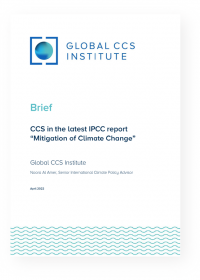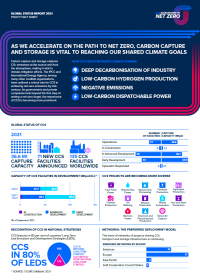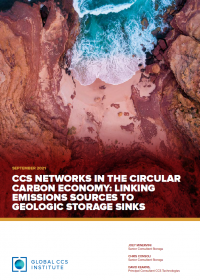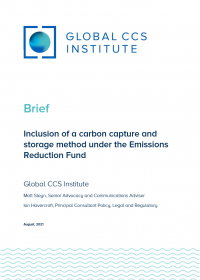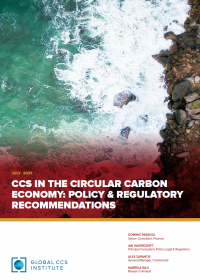Resources
Publications
Our publications, reports and research library hosts over 500 specialist reports and research papers on all topics associated with CCS.
View our Publication Library Disclaimer.
Filter by
Sequestering carbon dioxide (CO2) in subsurface geological formations in the United States presents a unique property law issue; pore space ownership.
This brief, authored by Ruth Ivory-Moore, Policy and Advocacy Manager for the Americas, summarizes the issue of pore space ownership within the U.S., and provides a brief overview of the current state of property right laws related to pore space ownership in nineteen different states.
Download the full brief below.
Disclaimer
The content within the Global CCS Institute Publications, Reports and Research Library is provided for information purposes only. We make every effort and take reasonable care to keep the content of this section up-to-date and error-free. However, we make no claim as to its accuracy, currency or reliability.
Content and material featured within this section of our website includes reports and research published by third parties. The content and material may include opinions and recommendations of third parties that do not reflect those held by the Global CCS Institute.
With the emergence of Carbon Capture and Storage as an essential tool to limit climate change impact and reduce emissions from energy intensive industries, interest in CCS has been growing at an unprecedented rate in recent years.
As a result of the key role played by CCS in the energy transition towards a net-zero future, the economic performance of CCS is becoming increasingly important and technology development fundamental to meet the demand for improved CO2 capture systems, transport costs and storage options.
In our inaugural Technology Compendium, authored by Dr. Nouman Mirza and Dr. David Kearns, we take a look at a wide range of commercially-available CCS technologies around the world and analyse technology developments in the context of CO2 capture, transport, storage and the full value chain.
Disclaimer
The content within the Global CCS Institute Publications, Reports and Research Library is provided for information purposes only. We make every effort and take reasonable care to keep the content of this section up-to-date and error-free. However, we make no claim as to its accuracy, currency or reliability.
Content and material featured within this section of our website includes reports and research published by third parties. The content and material may include opinions and recommendations of third parties that do not reflect those held by the Global CCS Institute.
Developments and Opportunities – A Review of National Responses to CCS Under the London Protocol
4th May 2022
In a perspective released by the Institute, authors Ian Havercroft and Chris Consoli explain how amendments to the London Protocol has enhanced prospects to scale up CCS. With greater flexibility under the London Protocol, including transboundary movement of CO2 aimed for storage now permitted, this perspective looks at how nations in Europe and Asia Pacific are responding to potential CCS opportunities provided with lessened regulatory barriers.
Disclaimer
The content within the Global CCS Institute Publications, Reports and Research Library is provided for information purposes only. We make every effort and take reasonable care to keep the content of this section up-to-date and error-free. However, we make no claim as to its accuracy, currency or reliability.
Content and material featured within this section of our website includes reports and research published by third parties. The content and material may include opinions and recommendations of third parties that do not reflect those held by the Global CCS Institute.
In a report released by the UN International Panel on Climate Change (IPCC) titled ‘Mitigation of Climate Change’, authors – part of Working Group III – pointed to the critical role carbon capture and storage (CCS) will play as a climate solution, on the urgent path to limit global warming.
The Institute takes a closer look at this key IPCC report in a newly released brief, authored by our Senior Policy Adviser on International Climate Change, Noora Al Amer. In it, the Institute unpacks the details of the IPCC findings, highlighting:
- The emissions mitigation potential CCS will provide a wide range of sectors, further supporting pathways to net-zero
- Where CCS stands on the UN’s Sustainable Development Goals
- How scaling CCS deployment can vary based on region
Download the brief below for the full overview.
Disclaimer
The content within the Global CCS Institute Publications, Reports and Research Library is provided for information purposes only. We make every effort and take reasonable care to keep the content of this section up-to-date and error-free. However, we make no claim as to its accuracy, currency or reliability.
Content and material featured within this section of our website includes reports and research published by third parties. The content and material may include opinions and recommendations of third parties that do not reflect those held by the Global CCS Institute.
As part of our series Understanding Carbon Capture and Storage, this newly released two-pager highlights what some of the world's foremost climate and energy experts have said about CCS as a necessary and viable technology to help reach net-zero.
The factsheet contains quotes from:
- Dr. Fatih Birol, Executive Director, the International Energy Agency (IEA)
- Prof. Heleen De Coninck, Associate Professor, Department of Environmental Science, Radboud University, Coordinating Lead Author of Chapter 4 of the IPCC Special Report on Global Warming of 1.5°C
- Dr. Jennifer Wilcox, Principal Deputy Assistant Secretary, Office of Fossil Energy and Carbon Management, U.S. Department of Energy, formerly Presidential Distinguished Professor of Chemical Engineering and Energy Policy at the University of Pennsylvania
- Prof. Jin Hongguang, Member of China Academy of Sciences, Chair Commissioner, CCUS Professional Committee, Chinese Society of Environmental Sciences
- Dr. Julio Friedmann, Chief Scientist at Carbon Direct, and non-resident fellow at the Center on Global Energy Policy at Columbia University
- Prof. Michael Gerrard, Andrew Sabin Professor of Professional Practice, Columbia Law School
- Prof. Niall Mac Dowell, Professor in Energy Systems Engineering, Imperial College London
- Lord Nicholas Stern, IG Patel Professor of Economics and Government, and Chairman of the Grantham Research Institute on Climate Change and the Environment at the London School of Economics
- Dr. Sally Benson, Deputy Director for Energy and Chief Strategist for the Energy Transition at the White House Office of Science and Technology Policy (OSTP)
Download the full factsheet below and follow the Institute on Twitter and LinkedIn for additional expert content.
Disclaimer
The content within the Global CCS Institute Publications, Reports and Research Library is provided for information purposes only. We make every effort and take reasonable care to keep the content of this section up-to-date and error-free. However, we make no claim as to its accuracy, currency or reliability.
Content and material featured within this section of our website includes reports and research published by third parties. The content and material may include opinions and recommendations of third parties that do not reflect those held by the Global CCS Institute.
Carbon capture and storage (CCS) continues to make significant progress around the world against a backdrop of greater climate action from countries and private companies. The Global Status of CCS 2021 demonstrates the critical role of CCS as nations and industry accelerate to net-zero.
The report provides detailed analyses of the global project pipeline, international policy, finance, and emerging trends. In addition, four regional overviews highlight the rapid development of CCS across North America, Asia Pacific, Europe and nearby regions, and the Gulf Cooperation Council states.
The Global Status of CCS report shows that global storage capacity has increased 32% in the last year alone. There are now 135 commercial CCS facilities in the project pipeline (27 are fully operational) from a diverse range of sectors including cement, steel, hydrogen, power generation and direct air capture.
Download the full Global Status Report 2021 in Arabic.
Disclaimer
The content within the Global CCS Institute Publications, Reports and Research Library is provided for information purposes only. We make every effort and take reasonable care to keep the content of this section up-to-date and error-free. However, we make no claim as to its accuracy, currency or reliability.
Content and material featured within this section of our website includes reports and research published by third parties. The content and material may include opinions and recommendations of third parties that do not reflect those held by the Global CCS Institute.
The Global Status of CCS report illustrates the critical role carbon capture and storage technology plays in reducing industrial emissions and documents the current and ongoing CCS efforts being undertaken to tackle climate change.
The Global Status of CCS factsheet highlights measures government and industry can take to achieve cost-effective net-zero emissions through CCS and also points to key milestones reached in the CCS space over the last year.
Download the Global Status of CCS Factsheet below:
Global Status of CCS - Factsheet - English
Global Status of CCS - Factsheet - Japanese
Global Status of CCS - Factsheet - Chinese
Disclaimer
The content within the Global CCS Institute Publications, Reports and Research Library is provided for information purposes only. We make every effort and take reasonable care to keep the content of this section up-to-date and error-free. However, we make no claim as to its accuracy, currency or reliability.
Content and material featured within this section of our website includes reports and research published by third parties. The content and material may include opinions and recommendations of third parties that do not reflect those held by the Global CCS Institute.
Carbon capture and storage (CCS) continues to make significant progress around the world against a backdrop of greater climate action from countries and private companies. The Global Status of CCS 2021 demonstrates the critical role of CCS as nations and industry accelerate to net-zero.
The report provides detailed analyses of the global project pipeline, international policy, finance, and emerging trends. In addition, four regional overviews highlight the rapid development of CCS across North America, Asia Pacific, Europe and nearby regions, and the Gulf Cooperation Council states.
The Global Status of CCS report shows that global storage capacity has increased 32% in the last year alone. There are now 135 commercial CCS facilities in the project pipeline (27 are fully operational) from a diverse range of sectors including cement, steel, hydrogen, power generation and direct air capture.
Disclaimer
The content within the Global CCS Institute Publications, Reports and Research Library is provided for information purposes only. We make every effort and take reasonable care to keep the content of this section up-to-date and error-free. However, we make no claim as to its accuracy, currency or reliability.
Content and material featured within this section of our website includes reports and research published by third parties. The content and material may include opinions and recommendations of third parties that do not reflect those held by the Global CCS Institute.
CCS Networks in the Circular Carbon Economy: Linking Emissions Sources to Geologic Storage Sinks
5th October 2021
Topic(s): Carbon capture and storage (CCS), CCS networks
Carbon capture and storage (CCS) networks linking emissions point sources to a CO2 transport and storage hub is emerging as the lowest-cost and most cost-effective method of CCS development. As part of the Circular Carbon Economy: Keystone to Global Sustainability series with the Center on Global Energy Policy at Columbia University SIPA, this report reviews emissions and storage basins worldwide, seeking to link clusters of emissions-intensive regions to potential geologic storage basins.
The report is presented in two parts:
- In part one, using a single methodology to characterise global emissions and basins, the authors perform a high-level, regional analysis identifying potential CCS networks by linking suitable storage to intense emissions centres across the globe
- In part two the authors present a conceptual approach to designing a CO2 transport network from distributed sources to a target geological formation for storage, outlining the selection of gas-phase and dense-phase pipeline transport as well as an approach to minimising the cost of pipelines over the network.
Key findings from the report include:
- Potential CCS networks can be identified in almost every industrialised region of the world.
- Those potential networks identified in this report can guide future detailed investigation and planning required for CCS network development.
- Each industrialised region of the world has access to storage resources ranked as highly suitable or suitable.
- The combination of emission sources in proximity to storage sinks means a global portfolio of CCS networks is technically possible. These networks provide the greatest opportunity to rapidly decarbonise large clusters of power and industrial sources.
- Inadequate characterisation of geologic storage resources is the critical limiting factor to CCS network development across the globe.
- Comprehensive national assessments are still needed for the majority of nations. Until these assessments are completed, insufficient understanding of geologic storage resources will remain a significant barrier to CCS network development.
- Pipeline and compression networks require the development of cost models for piping and compression systems for the specific country and local costs of energy and construction. This provides the quantitative basis for decisions in network design.
Disclaimer
The content within the Global CCS Institute Publications, Reports and Research Library is provided for information purposes only. We make every effort and take reasonable care to keep the content of this section up-to-date and error-free. However, we make no claim as to its accuracy, currency or reliability.
Content and material featured within this section of our website includes reports and research published by third parties. The content and material may include opinions and recommendations of third parties that do not reflect those held by the Global CCS Institute.
Inclusion of a CCS Method Under the Emissions Reduction Fund
12th August 2021
Topic(s): Australia, CCS policy
The Emissions Reduction Fund (ERF) is the carbon crediting scheme in Australia through which the Federal Government purchases lowest cost carbon abatement from a range of sources. The fund looks to provide a market-based mechanism that encourages the pursuit of general emissions reductions within the broader context of climate mitigation.
In 2020 the Australian Government’s Low Emissions Technology Statement identified carbon capture and storage (CCS) as one of several priority low emissions technologies. At the request of the government and against the backdrop of emerging projects, the Clean Energy Regulatory began developing a CCS method (or methodology) under the Emissions Reduction Fund. Inclusion under the ERF would allow CCS projects to generate Australian Carbon Credit Units (ACCUs) and thereby generate income.
This brief from Senior Advocacy and Communications Adviser, Matt Steyn, and Principal Consultant Policy, Legal and Regulatory, Ian Havercroft, explains what the Emissions Reduction Fund is, examines how it works and explores the the inclusion of CCS as a methodology.
Disclaimer
The content within the Global CCS Institute Publications, Reports and Research Library is provided for information purposes only. We make every effort and take reasonable care to keep the content of this section up-to-date and error-free. However, we make no claim as to its accuracy, currency or reliability.
Content and material featured within this section of our website includes reports and research published by third parties. The content and material may include opinions and recommendations of third parties that do not reflect those held by the Global CCS Institute.
Between 23 April and 21 May, 2021, the Global CCS Institute hosted a series of three webinars every other Friday from 10-11 am Eastern Time, titled The Carbon Capture and Storage 101 Webinars. The first webinar focused on “Introducing a CCS Project,” the second was on “CCS Infrastructure for a Net-Zero Future,” and the third was titled “CCS Policy for a Net-Zero Future.”
These webinars generated an extraordinary number of questions – 101 in total. Their breadth and depth emphasised the many technological, financial, geographical, social, and political aspects of CCS that must be met to achieve the scale-up required to manage climate change. These questions also clearly indicate the need for more educational materials on CCS.
This brief seeks to fill that void by answering the 101 questions from the CCS 101 webinars. It should be an especially effective educational tool because it deals with specific themes in the CCS universe that are either misunderstood, mischaracterized, or missing information to a very diverse audience composed of experts and non-experts alike. Indeed, questions came from industry representatives, academics, Capitol Hill staffers, members of the press, and the general public. Some were extremely technical and some quite general. Accordingly, some required detailed, nuanced answers and some no more than a few words. Regardless, with nearly 1000 people attending at least one webinar in the CCS 101 Series, it is likely that these questions represent the queries of a broad swath of the public interested in developing or investing in a CCS project. The answers provide a rich tableau of insights into the current status and future potential of CCS.
Disclaimer
The content within the Global CCS Institute Publications, Reports and Research Library is provided for information purposes only. We make every effort and take reasonable care to keep the content of this section up-to-date and error-free. However, we make no claim as to its accuracy, currency or reliability.
Content and material featured within this section of our website includes reports and research published by third parties. The content and material may include opinions and recommendations of third parties that do not reflect those held by the Global CCS Institute.
CCS in the Circular Carbon Economy: Policy and Regulatory Recommendations
23rd July 2021
Topic(s): Carbon capture and storage (CCS), CCS finance, CCS investment, Policy law and regulation
CCS is one of many climate mitigating technologies that is mature, commercially available, and absolutely necessary to achieve global net-zero ambitions and a stable climate. The total installed CCS capacity must increase 100-fold by 2050 to limit global warming to below 2° Celsius.
This report summarises policy and legal factors that have a material impact on the investability of CCS projects and makes recommendations on how governments may facilitate greater private sector investment in CCS.
The report examines and covers:
- Financing CCS
- The development of CCS-specific legal and regulatory frameworks
- Recommendations addressing policy, finance and regulatory matters
Disclaimer
The content within the Global CCS Institute Publications, Reports and Research Library is provided for information purposes only. We make every effort and take reasonable care to keep the content of this section up-to-date and error-free. However, we make no claim as to its accuracy, currency or reliability.
Content and material featured within this section of our website includes reports and research published by third parties. The content and material may include opinions and recommendations of third parties that do not reflect those held by the Global CCS Institute.



